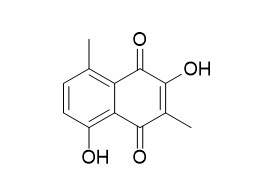Aristolindiquinone
Reference standards.
Inquire / Order:
manager@chemfaces.com
Technical Inquiries:
service@chemfaces.com
Tel:
+86-27-84237783
Fax:
+86-27-84254680
Address:
1 Building, No. 83, CheCheng Rd., Wuhan Economic and Technological Development Zone, Wuhan, Hubei 430056, PRC
Providing storage is as stated on the product vial and the vial is kept tightly sealed, the product can be stored for up to
24 months(2-8C).
Wherever possible, you should prepare and use solutions on the same day. However, if you need to make up stock solutions in advance, we recommend that you store the solution as aliquots in tightly sealed vials at -20C. Generally, these will be useable for up to two weeks. Before use, and prior to opening the vial we recommend that you allow your product to equilibrate to room temperature for at least 1 hour.
Need more advice on solubility, usage and handling? Please email to: service@chemfaces.com
The packaging of the product may have turned upside down during transportation, resulting in the natural compounds adhering to the neck or cap of the vial. take the vial out of its packaging and gently shake to let the compounds fall to the bottom of the vial. for liquid products, centrifuge at 200-500 RPM to gather the liquid at the bottom of the vial. try to avoid loss or contamination during handling.
Life (Basel).2022, 12(12):2107.
J Inflamm Res.2022, 15:5347-5359.
Planta Med.2018, 84(6-07):465-474
Enzyme Microb Technol.2022, 161:110111.
Spectrochim Acta A2019, 210:372-380
Acta Physiologiae Plantarum2016, 38:7
Chinese Pharmacological Bulletin2019, 35(8):1120-1125
Food Chem.2017, 221:1135-1144
Int J Mol Sci.2023, 24(18):14077.
J Appl Toxicol.2024, jat.4615.
Related and Featured Products
J Nat Prod. 1984 Mar-Apr;47(2):331-41.
Studies on Aristolochia III. Isolation and biological evaluation of constituents of Aristolochia indica roots for fertility-regulating activity.[Pubmed:
6539809]
METHODS AND RESULTS:
An ethanol extract of Aristolochia indica roots decreased fertility in both rats and hamsters when administered postcoitally (days 1-10 and 1-6, respectively). Petroleum ether (A), CHCl3 (B), and aqueous (C) fractions, tested similarly in rats, were inactive and/or toxic. Partition of fraction B afforded non-acidic (D) and acidic (E) fractions.
CONCLUSIONS:
Savinin (1), isolated from fraction D and not previously reported from the Aristolochiaceae , was inactive when administered postcoitally to rats.
Aristolochic acid-I (2), reported previously from A. indica and isolated from fraction E, was inactive when administered postcoitally to rats and toxic when administered postcoitally to hamsters. (12S)-7,12- Secoishwaran -12-ol (3), previously reported from A. indica and isolated from fraction A, did not interrupt pregnancy when administered to mice on day 6 of pregnancy. Four additional compounds, aristolic acid (4) [prepared from aristolochic acid-I (2)], methyl aristolate (5) [prepared by methylating aristolic acid (4)], and cis- and trans-p-coumaric acid (both oblate commercially), were similarly tested in mice and found to be inactive. Aristolic acid (4), and the cis- and trans-p-coumaric acids also were inactive when administered postcoitally (days 1-10) to rats.
Seven compounds reported previously from A. indica were also isolated, as were a new naphthoquinone, Aristolindiquinone (6) (fraction E), and magnoflorine (fraction C).



